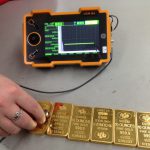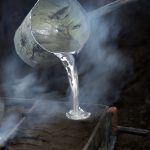 In this latest entry of our series on non-destructive assays, we’ll be covering two tests that start out the same way, but require vastly different equipment. Both assays require a sample that must be scraped away from the test object. Even though this can mark the object, the “damage” is minor and easily repaired.
In this latest entry of our series on non-destructive assays, we’ll be covering two tests that start out the same way, but require vastly different equipment. Both assays require a sample that must be scraped away from the test object. Even though this can mark the object, the “damage” is minor and easily repaired.
Acid testing
At MGS, we use acid assays every day to evaluate gold purity so we can pay a fair price for it. First, a sample is collected by scraping the object in question against a touchstone (usually made of basalt, slate, or another dark-colored stone with a fine-grained surface) – leaving a visible streak. By applying different concentrations of nitric acid to the streak and measuring the reaction, we can determine the presence of precious metals and accurately estimate their purity. For example, stronger concentrations of acid will dissolve silver and lower-karat gold, while pure gold and platinum will be unaffected.
While the acid assay is a quick, easy, and accurate method for confirming the presence or absence of precious metals, it doesn’t tell you much else about a sample. For a detailed analysis without damage, you’ll need…
Energy-dispersive X-ray spectroscopy (EDS)
A scanning electron microscope with EDS capabilities can measure the chemical and physical characteristics of a sample at the particle level. In principle, EDS is very similar to the X-RF assay we offer our clients. The essential difference is that the X-RF assay exposes a sample to x-rays and measures the fluorescence emitted, while EDS focuses an electron beam on a sample and measures the x-rays emitted. Each element’s emission spectrum is unique to its atomic structure, so you can determine the exact composition of a sample by analyzing its emissions. In other words, not only can EDS tell you if a sample contains gold, it can tell you what impurities are also present and in what ratios. For example, the EDS results for a piece of gold jewelry would look something like this:
- 29.6% Copper
- 2.48% Zinc
- 8.17% Silver
- 59.74% Gold
- 100% Total Mass
It’s also worth noting that the size of the sample can be extremely small – even smaller than what an acid assay requires. Unfortunately, the extremely detailed test results are not worth the cost for most people.











